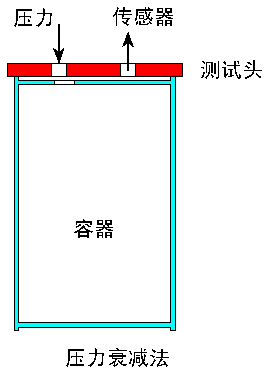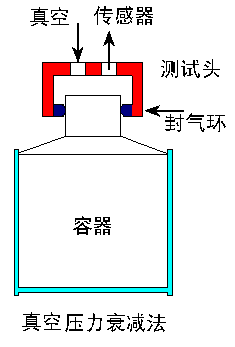Development of metal container leak detection technology
Yang Wenliang
In recent years, the manufacturing technology of metal containers in China has made great progress with the development of the economy. However, in contrast, the development of leakage detection technology for metal containers has lagged significantly, especially the leak detection technology for steel drums. Staying at the level of the 1950s and 1960s obviously cannot keep pace with the development of related technologies at home and abroad. Therefore, the leak detection technology of metal containers in China needs to be improved.
In developed countries abroad, the detection of leakage of metal containers has been taken seriously by the legislature, which has made various relevant standards and norms more and more strict and clear. Therefore, in order to control and ensure the quality of the production and use of metal containers, our production companies must have a clear understanding of the latest testing techniques and testing methods.
For metal containers, there have been many losses, pollutions and hazards caused by leakage for a long time. With the development of society, we pay more and more attention to product quality, environmental pollution and human health. Metal containers must be zero-permeable. leak. In foreign technical terms, “the container must not leak, and the inside of the container must maintain the original pressureâ€. Such concepts have a clear definition in international standards.
Leakage inspection has three main purposes: one is to prevent the leakage of the contents of the container, so as not to affect the use of its products; the second is to prevent environmental pollution (hazard or harmful substances) caused by leakage; the third is to prevent The contents are contaminated, allowing unreliable ingredients (incompatible ingredients) to reach the end consumer.
For many years, the leakage test of metal containers has been commonly used in various forms of blister test. The test method of this test is relatively simple. It is to put the container in water or apply soapy water to the common leak on the container. Compress air is introduced into the container to see if a container placed in the water is bubbling to determine if the container is leaking. This method abounds in our national standards and has become a traditional, standard method. Although this method can detect very small leaks and find out the exact position, this method can not measure the exact leak rate, and has the following disadvantages: First, the detection efficiency is low and the labor intensity is large. In modern, fully automated production lines, it is almost impossible to detect all of the blister leaks in metal containers. Second, the detection of blister leakage After the inspection, the surface of the metal container has been contaminated by water, and must be processed before entering the next process, otherwise the surface may be rusted or affect the quality of the subsequent coating.
Recently, a new type of container leak detection system has been successfully researched in Italy. The system uses a suitable dry air leak sensor with a computing device and a microprocessor-controlled test system that is accurate and faster. The test cycle can be adapted to more stringent anti-leakage specifications.
Since 1974, Italy's Bonfiglioli Engineering Company has specialized in the design and manufacture of leak test equipment, providing leak test methods for various packaging container industries, and has earned a high reputation worldwide. He has become the world's container tester. Representative of technology. In recent years, continuous research and development has made the company a world leader in the field of leak testers. In order to meet the needs of various containers, they are designed and manufactured to CE standards for each device to meet leak detection in any container.
At present, in some automatic drum production lines in China, most of them are equipped with a relatively primary leakage system, which is the result of digestion and absorption by foreign advanced technology equipment, but in practical applications, the effect is often unsatisfactory. The method is to use the principle of pressure decay, which is undetectable for testing containers filled with objects and sealed. The latest technology is vacuum attenuation method. Now briefly introduced as follows.
First, the pressure decay method
In this type of test device, air is continuously blown into the container until its internal pressure reaches a predetermined value, or a predetermined time has elapsed. During the test cycle, the pressure within the vessel is monitored, and depending on the pressure change, and the pressure value is compared to a predetermined threshold, the vessel will be judged to be pass or fail.

The principle of this test is: when the container enters a certain amount of compressed air, if the container does not leak, the compressed air will maintain a given pressure; if the container leaks, the gas will partially leak out, and the pressure inside the container will also decline. This requires that before the compressed air enters the container, it must first be depressurized, regulated, and stabilized so that the stabilized compressed air can remain at the precise leakage pressure point after entering the container. Then install a high-precision pressure relay (pneumatic component or trigger, pneumatic diaphragm logic component) in the air inlet container to measure the small pressure drop in the barrel and convert it into an electrical signal or gas signal to enter the execution system notification operation. By. Signaled control systems can also be used to dial leaking containers into the unacceptable stack.
Second, the vacuum attenuation method
In this type of test device, the container being tested is sealed and is typically filled with liquid leaving only a vent at the top of the container. A test head with a gas seal ring is inserted into the mouth of the container, and when pressurized, the gas seal ring abuts against the wall of the container to provide a strong sealing effect. The sealed test chamber creates a vacuum due to the air being drawn away. During the entire test cycle, the special sensor controls the vacuum in the test tank from start to finish.
Third, helium detection method

This type of test device utilizes helium as a principle for tracking gas to be sensitive to various parts of the container. The helium gas detection device consists of three parts: a detection chamber, a high vacuum chamber and a gas analyzer. During the test, the helium gas was fully diffused in the container. The helium-filled container enters the vacuum chamber and starts the vacuum pump. The gas analyzer immediately displays the percentage of helium. A small amount of helium can trigger the reject system. When the bell rings, the defective container is taken from the other. The conveyor belt is delivered.
Fourth, the load cell method
The load cell method is generally used for the airtightness test of a metal bag container, and the gas tightness of the container is tested by using a load cell. The bag being tested is placed on the lower conveyor, and the upper conveyor is above the bag and its height is adjustable. The upper conveyor compresses the tested area of ​​the bag placed on the lower conveyor. The movement of the two transmitters is synchronous. On the lower conveyor, there is a gravity balance at the entrance and exit of the test cycle.
The gravity balance at the beginning of the test cycle is first read. The size and elasticity of the bag determines the pressure exerted on the bag by the upper conveyor.
At the end of the test cycle, the gravity balance reads the second data. If the data measured by the two balances are equal or less than the predetermined upper limit, the bag can be considered qualified. Otherwise, if the difference between the two readings is greater than the predetermined upper limit, the bag is an unqualified product.
Advanced leak detection technology not only has high production efficiency, high precision, but also has no effect on the quality of the container itself. Due to China's metal container packaging industry, especially the barrel industry, the technology is relatively backward, most companies only pay attention to the production technology of metal containers, and make great efforts to improve and introduce intermediate production equipment, which has not caused enough leakage detection technology. The emphasis is on, so even if the production equipment is more equipment manufacturers, the detection technology stays in the original and backward state. This is a very abnormal phenomenon.
At present, China's metal container leakage detection technology needs to be improved. It is hoped that enterprises will not neglect the improvement of the leak detection technology of containers when they are vigorously improving and purchasing advanced production equipment. They also hope that relevant research departments and metal container production equipment Manufacturing enterprises should pay attention to the introduction, digestion and absorption of foreign leakage detection technology, and make efforts for the early improvement of leakage detection equipment in China's metal container industry.
Steel Leveler Feet,Stainless Steel Adjustable Feet,Stainless Steel Leveling Feet,Adjustable Metal Feet
Cixi Ruixin Machine Components Co., Ltd , https://www.adjustlevelingfeet.com